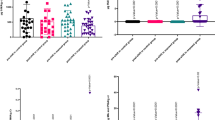Abstract
Aircraft cabin air can possibly be contaminated by tricresyl phosphates (TCP) from jet engine oils during fume events. o-TCP, a known neurotoxin, has been addressed to be an agent that might cause the symptoms reported by cabin crews after fume events. A total of 332 urine samples of pilots and cabin crew members in common passenger airplanes, who reported fume/odour during their last flight, were analysed for three isomers of tricresyl phosphate metabolites as well as dialkyl and diaryl phosphate metabolites of four flame retardants. None of the samples contained o-TCP metabolites above the limit of detection (LOD 0.5 μg/l). Only one sample contained metabolites of m- and p-tricresyl phosphates with levels near the LOD. Median metabolite levels of tributyl phosphate (TBP), tris-(2-chloroethyl) phosphate (TCEP) and triphenyl phosphate (TPP) (DBP 0.28 μg/l; BCEP 0.33 μg/l; DPP 1.1 μg/l) were found to be significantly higher than in unexposed persons from the general population. Median tris-(2-chloropropyl) phosphate (TCPP) metabolite levels were significantly not higher in air crews than in controls. Health complaints reported by air crews can hardly be addressed to o-TCP exposure in cabin air. Elevated metabolite levels for TBP, TCEP and TPP in air crews might occur due to traces of hydraulic fluid in cabin air (TBP, TPP) or due to release of commonly used flame retardants from the highly flame protected environment in the airplane. A slight occupational exposure of air crews to organophosphates was shown.

Similar content being viewed by others
References
Abou-Donia MB, Nomeir AA, Bower JH, Makkawy HA (1990) Absorption, distribution, excretion and metabolism of a single oral dose of [14C]tri-o-cresyl phosphate (TOCP) in the male rat. Toxicology 65:61–74. doi:10.1016/0300-483X(90)90079-V
Burka LT, Sanders JM, Herr DW, Matthews HB (1991) Metabolism of tris-2-chloroethyl) phosphate in rats and mice. Drug Metab Dispos 19:443–447
Craig PH, Barth M (1999) Evaluation of the hazards of industrial exposure to tricresyl phosphate: a review and interpretation of the literature. J Toxicol Environ Health B Crit Rev 2:281–300. doi:10.1080/109374099281142
Denola G, Hanhela PJ, Mazurek W (2011) Determination of tricresyl phosphate air contamination in aircraft. Ann Occup Hyg 55:710–722. doi:10.1093/annhyg/mer040
Henschler D (1958) Die Tricresylphosphatvergiftung. Experimentelle Klärung von Problemen der Ätiologie und Pathogenese. Klin Wochenschr 36:663–674
IPCS (International Program on Chemical Safety) (1990) WHO (World health organisation), trikresyl phosphate. EHC 110
Kurebayashi H, Tanaka A, Yamaha T (1985) Metabolism and disposition of the flame-retardant plasticizer, tri-para-cresyl phosphate, in the rat. Toxicol Appl Pharmacol 77:395–404
Larsen K (1972) Creatinine assay by a reaction-kinetic principle. Clin Chim Acta 41:209–217
Liyasova M, Li B, Schopfer LM, Nachon F, Masson P, Furlong CE, Lockridge O (2011) Exposure to tri-o-cresyl phosphate detected in jet airplane passengers. Toxicol Appl Pharmacol 256:337–347. doi:10.1016/j.taap.2011.06.016
Nomeir AA, Abou-Donia MB (1986) Studies on the metabolism of the neurotoxic tri-o-cresyl phosphate. Distribution, excretion, and metabolism in male cats after a single, dermal application. Toxicology 35:15–33
Ross SM (2008) Cognitive function following exposure to contaminated air on commercial aircraft: a case series of 27 pilots seen for clinical purposes. J Nutr Environ Med 17:111–126. doi:10.1080/13590840802240067
Schindler BK, Förster K, Angerer J (2009a) Determination of human urinary organophosphate flame retardant metabolites by solid-phase extraction and gas chromatography-tandem mass spectrometry. J Chromatogr B Analyt Technol Biomed Life Sci 877:375–381. doi:10.1016/j.jchromb.2008.12.030
Schindler BK, Förster K, Angerer J (2009b) Quantification of two urinary metabolites of organophosphorus flame retardants by solid-phase extraction and gas chromatography-tandem mass spectrometry. Anal Bioanal Chem 395:1167–1171. doi:10.1007/s00216-009-3064-6
Solbu K, Daae HL, Olsen R, Thorud S, Ellingsen DG, Lindgren T, Bakke B, Lundanes E, Molander P (2011) Organophosphates in aircraft cabin and cockpit air-method development and measurements of contaminants. J Environ Monit 13:1393–1403. doi:10.1039/c0em00763c
Suzuki T, Sasaki K, Takeda M, Uchiyama M (1984) Metabolism of tributyl phosphate in male rats. J Agric Food Chem 32:603–610. doi:10.1021/jf00123a046
WHO (World Health Organisation) (1991). Tri-n-butyl phosphate, EHC 112, Genf
Winder C, Michaelis S (2005a) Aircraft air quality malfunction incidents: causation, regulatory, reporting and rates. In: Hutzinger O (ed) Handbook of environmental chemistry, vol 4. Springer, Berlin, pp 211–228. doi:10.1007/b107245
Winder C, Michaelis S (2005b) Crew effects from toxic exposures on aircraft. In: Hutzinger O (ed) Handbook of environmental chemistry, vol 4, Part H. Springer, Berlin, pp 211–228. doi:10.1007/b107245
Acknowledgments
The authors thank the BG Verkehr (German Social Accident Insurance Institution for the transport industry) for their financial support.
Conflict of interest
The authors declare that they have no conflict of interest.
Author information
Authors and Affiliations
Corresponding author
Rights and permissions
About this article
Cite this article
Schindler, B.K., Weiss, T., Schütze, A. et al. Occupational exposure of air crews to tricresyl phosphate isomers and organophosphate flame retardants after fume events. Arch Toxicol 87, 645–648 (2013). https://doi.org/10.1007/s00204-012-0978-0
Received:
Accepted:
Published:
Issue Date:
DOI: https://doi.org/10.1007/s00204-012-0978-0




